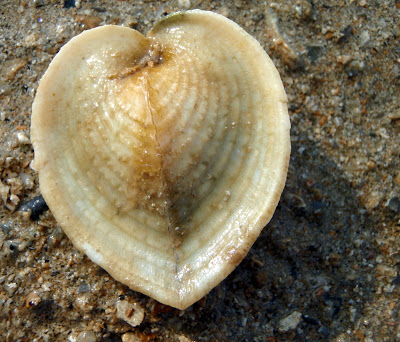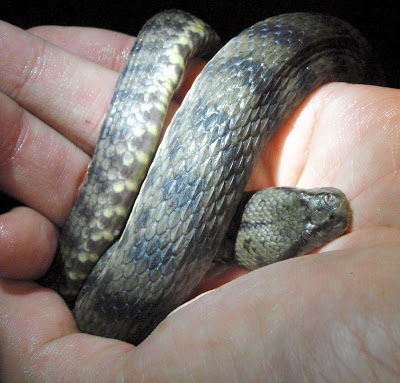(Entry @ 28 Dec 2007: For fifth 'discovery', Flat worms belong to a different Phylum as sea slugs, so flat worms are not sea slugs. Thanks, Ria for the information.)
Good Afternoon Semakau~ A second day on the serene and out of Singapore feel island is where we were again yesterday.
And today, we had KC, who just returned not long ago from her months of travel, to hold the tag of "If we don't see anything interesting today, then blame me". hahaha.
Anyway, in the afternoon walks on Semakau Land fill island, the participants were treated to a presentation by NEA staff on the land fill island and then brought on a land fill tour to the southern most part of Singapore where the public can access.
Here's the road that leads to the southern most part of the island (picture below) and according to NEA, there was a couple who came recently to the island to have their wedding photos taken, talk about out of the norm. =P
 And the last item of the visit was the highlight of the trip to the island, the inter-tidal walk~
And the last item of the visit was the highlight of the trip to the island, the inter-tidal walk~Went past the usual mangrove stop quite quickly as the mosquitoes were still swamping my group in numbers (especially me -_-" ) to find our first 'discovery', a 'baby' common seastar (picture below).
 Discovery Note:
Discovery Note:1. Although people commonly call them star fish, we prefer to call them sea stars. As they are not fishes.
2. If you look on the underside of the sea star, you will find the tube feet of the sea star.
3. These tube feet are used for walking, handle food as well as breathing, talk about multi purpose!
4. Sea stars get stressed when out of water, so please don’t take them out of the water for too long.
5. And although they are called the common seastars, they are no longer common due to over collection and habitat lost, let's hope with the sight of this young one will give us hope of more young ones to appear on our shores. =)
The second 'discovery' was a sandfish sea cucumber, and one of the 'Sea Slugs', i was head 'Sea Slug' of the day, pointed out another sandfish sea cucumber also.. Great eyesight!
 Discovery Note:
Discovery Note:1. Being related to the sea stars, sea cucumbers have a soft, wormlike body and range from a few centimeters to 90 centimeters in length.
2. Unlike the sea star, however, they have no arms but use a cluster of tube-like feet around their mouth to gather food.
3. To repel predators or when stressed, a sea cucumber might expel their innards or ‘vomit’. And if too much of their innards are expelled, they might die off as a result.
4. The sandfish sea cucumber is the species of sea cucumber which people consume. But they contain toxins, so it must be properly prepared before consumption.
Third 'discovery' of the day was a moon crab, this moon crab does look a bit different from the ones we usually see though... ahem...
 Discovery Note:
Discovery Note:1. Instead of the usual walking legs we see on crabs, all four pairs of legs of the moon crab are paddle like.
2. This helps the crab to swim and used as spades to quickly bury themselves into the sand.
3. These crabs normally burrow just below the surface during the day.
4. They feed on small shellfish, worms and other animals and they usually eat at night.
Fourth 'discovery' is something which was spotted quite some time ago, but i never had the luck to chance upon it. But yesterday was my lucky day, that something is this outstanding green sunflower mushroom coral (picture below).
 Discovery Note:
Discovery Note:1. Most mushroom corals do not form colonies like most other corals and most mushroom coral is usually a single polyp.
2. Unlike most corals, most mushroom corals are attached to the reef only when they are small.
We also came into encounter with ourselves, sea slugs meet sea slugs (picture below)! Fifth 'discovery'!
Entry @ 28 Dec: Sea slugs belong to the Phylum Mollusca, while flatworms belong to the Phylum Platyhelminthes, so they are not the same. And therefore fifth 'discovery' should be flat worms.
 Discovery Note:
Discovery Note:1. Flatworms are hermaphrodite, which means a flatworm has both the male and female sex organs.
2. And certain species of flatworms engage in penis fencing, in which two individuals fight, trying to pierce the skin of the other with their penises; the first to succeed inseminates the other, which must then carry and nourish the eggs.
After the meeting ourselves session, we soon saw a blue spotted stingray (picture below), wow, KC was doing a great job and of course, Luan Keng who was with her too. =P Anyway, this is the sixth 'discovery'!
 Discovery Note:
Discovery Note:1. The position of the eyes allows the blue spot stingray to see almost behind it.
2. The gills and mouth are found on the underside of the body.
3. The blue spot stingray doesn't really have teeth—instead, the mouth is outfitted with two food-crushing plates.
4. Rays dart away when they sense trouble approaching. When caught off guard, these fish fend off predators with a flick of the tail, which is equipped with two venomous spines. Since its tail is so long, the blue spot stingray can even strike at animals directly in front of it.
5. The large tail spine of the blue spot stingray is dangerous and even deadly. The barbs in the tail are so large; people have bled to death from a sting.
With the great sunset as the background, the iconic knobby seastar as the 'mascot', and 'Sea Slugs' as the main cast, here's a group photo(picture below), thank you everyone for being such great 'Sea Slugs'! =)
















































